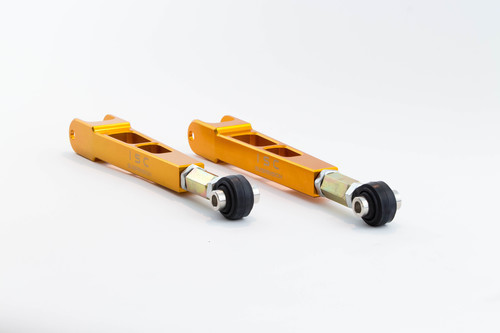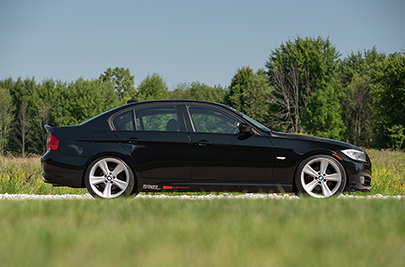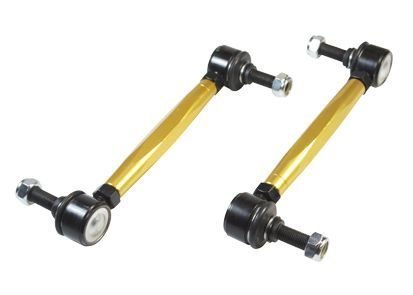What is the purpose of adjustable endlinks and how do they relate to coilovers?
When we’re talking about adjustable suspensions, most drivers typically only think of adjustable height coilovers…..or at least that’s the first thing that comes to mind. In reality there are multiple “pieces” of a suspension that are adjustable. Some of these include tie rods, control arms, coilovers, camber arms, bushings, eccentric bolts and more. One of the pieces that correlates more with adjustable coilovers than some of the other adjustable parts, are adjustable end links.

Let’s think about suspension geometry for a second and understand why adjustable end links might come in to play. Most people choose to install a coilover suspension for height adjustment. They want to be able to dial in the perfect ride height that they envision for their vehicle. So, they go out and find the suspension that best fits their needs and wait for it to arrive on their doorstep from their chosen supplier. Now comes the install. Nowadays DIY (do-it-yourself) is more popular than ever. Maybe it’s because of YouTube or something else, but more and more people are working on their own vehicle. So, you get the car up on jack stands and start installing your brand new coilovers. Once installed you sit back and look at your prized possession with its new stance and say, “Wow, look at that!”. Then you go out for a drive and think, “Dude, this things handles awesome!”…….and “what’s that noise?”

You get the car back where you did the install, put it up on jack stands (or a lift) and check over all the bolts that you unbolted to make sure everything’s tight. Yup, all good. Next you check out that brand new suspension that you just installed to make sure everything is good. Yup, all good. So, you decide to bring it for another test drive. “What’s that noise?”. You bring it back again and do the same thing. Maybe you do this 3 or 4 times, double and triple checking EVERYTHING……….except something that you can’t see while the car is in the air.
See you have “the perfect ride height” dialed in and your new coilovers lowered the car 2-3″ to get rid of that hideous wheel/fender gap. Now it’s PERFECT! When the car is parked on the side of the road or at the next big meet/show, your car looks “dope”. But the ride is a “nope”. Every bump you hit, you’re hearing a noise……..a slight clunk. Remember when we talked about adjustable suspension up top (^^^)? Well you just adjusted your suspension down to the ground, but bolted all the other suspension components back in as normal. While the ride height dropped 2-3″, the other components are still looking for that factory ride height. So, what’s that mean? Well, for starters, your factory sway bar links are likely too long and depending on the suspension set up and geometry of your specific chassis, they might be hitting on something (like maybe a lower control arm).

So let’s talk about sway bar end links and sway bars for a brief moment. Most modern day cars come with a sway bar in the front and a sway bar in the rear (this wasn’t always the case though). The sway bar, or otherwise known as the anti roll bar, works in conjunction with the springs and dampers/shocks to help mediate “roll” in the chassis when cornering. Essentially your sway bar is just another spring. As the car starts to roll, the sway bar, which is attached to both sides of the suspension (left to right) as well as to the chassis (in the middle), will twist and do it’s best to keep the left and right sides of the suspension “together”. Without a sway bar, as the car starts to “roll”, one side of the suspension would compress and the other side would just “hang”. They wouldn’t work “together”. From the factory most sway bars sit parallel to the ground when the suspension is at rest on the road (not drooped in the air or fully compressed in a corner). When this is the case, there should be no preload on the sway bar meaning it is not adding any tension to the vehicles suspension. In order for this to happen after you just lowered your car, you need a shorter sway bar end link because now the suspension geometry including suspension lengths have changed.
So what happens without an adjustable end link? Can the factory link still be installed if the car is lowered 2-3″? With a stiffer suspension, do I even need a sway bar? Well, first things first. In most applications the factory link CAN be re-installed. Whether it adds preload to the sway bar (and therefore the suspension) depends on the chassis, application and how much you lowered the car. Again, as mentioned above, it’s not recommended to use the factory link if it adds preload. Why? Because you are loading up one side of the suspension more than other and it will make the car handle very strange when cornering (the higher the speed, the scarier it gets sort of strange). Put it this way, would you lower one side of the car drastically more than the other? Of course not. What about not running a sway bar? Believe it not, this can be somewhat common depending on how the car is being used. In fact, none of our 350Z drift cars use a front sway bar. And, in some specific chassis’s, drivers choose not to run rear sway bars because it makes the rear end too stiff.
So, how do you determine what length adjustable sway bar link is needed? Easy. You measure. While the car is on the ground, you position the sway bar ends to be parallel to the ground. Then you measure from the mounting point on the sway bar to the mounting point of the chassis. This is the length of the adjustable sway bar that you need. It’s that simple!
Obviously this is just the basics of suspension “tuning” and how different parts of a cars suspension works. Just keep in mind that usually when you install one part on your car, it’s probably going to affect another part…..or something else on the car. Whether it’s engine components, drivetrain components, brake components or suspension components. The car needs to be “balanced” and working together, not against itself.
Related Links
Why is it Important to Properly Align Your Suspension?
Monotube Vs Twin-Tube – What is the Difference? What is Better?
What is an Air Cup and How Do they Work?
BMW X-Drive Coilovers & Suspension
ISC Suspension Valving Options: Which One is Right for You?
SWIFT Springs; Optional Upgrade for many ISC Coilovers
Product Feature: ISC 240SX Rear TOE ARM
How to Setup a Drift Car – Proper Drift Settings
Triple S Coilover Springs – Does it Make a Difference?
What is the Best Coilover Ride Height for My Car?
ISC V3.1 Rear Adjustable Control Arms
Upgrades to Consider when Installing Coilovers
Should I install coilovers on my car?
What is the purpose of adjustable end links and how do they relate to my coilovers?
Difference between ISC N1 and Basic, which to choose?
